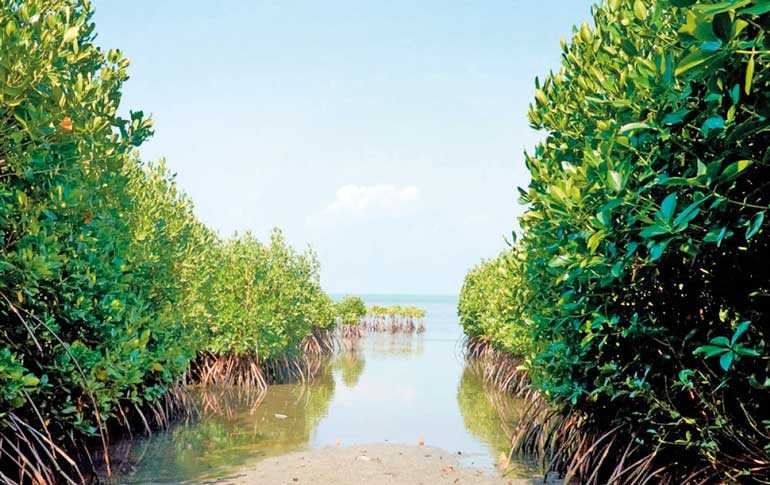Thursday Jun 26, 2025
Thursday Jun 26, 2025
Thursday, 7 February 2019 00:02 - - {{hitsCtrl.values.hits}}

On the border between land and sea, a unique ecosystem covers tropical and subtropical regions around the world: Mangrove forests. Mangroves are well adapted to saline water and the tides, and they thrive along the coastlines of over 118 countries, including Sri Lanka. They offer a wide variety of ecosystem services, provide a sheltered habitat for many species of animals, and are vital allies in the fight against climate change.
Sheltered habitats and unique ecosystem services
Mangroves are protectors of the coast and of the people that live around them. They form a green barrier that can hold off coastal erosion, storm surges, and even tsunamis. They are also blue lungs for the planet, storing up to five times as much carbon as other types of forests, which they bind under water and do not release after their death. They live in conditions that other trees cannot survive, and their extensive root systems create a unique environment for fish, birds, reptiles, amphibians, crustaceans, and many other animals and plants.
Mangrove forests offer sheltered habitats and nurseries for countless species of fish, algae, seagrass, corals, oysters, barnacles, molluscs, shrimps, and crabs, as well as a hospitable environment for birds, bats, insects, water monitors, fishing cats, crocodiles, and monkeys. They are sources of wood, fibre, charcoal, and ingredients for cosmetics, perfumes, pharmaceuticals, and tanneries. One third of Sri Lanka’s population lives in coastal areas, and many of them depend on mangroves for their livelihoods in fisheries.
Coastlines under threat
Combine all of this, and they provide essential services for both climate change mitigation and adaptation: but at the same time, they are under threat. In the last three decades, more than 50% of Sri Lanka’s mangroves have been destroyed due to prawn farming, hotel development, settlements, logging, tourism, agriculture, and pollution. It is now illegal to fell mangroves, and Sri Lanka has become the world’s first country to protect the entirety of its mangrove forests: but immense damage has already been done. The Sri Lankan Forest Department states the extent of mangroves at 15,670 hectares based on a 2010 survey while IUCN estimates put mangrove cover at around 12,000 hectares. The majority of mangroves is concentrated in the districts of Puttalam, Jaffna, Trincomalee, and Batticaloa. There are over 20 true mangrove species native to the island, and a multitude of animals and plants that depend on mangrove ecosystems.
Planting and protecting mangroves
Restoring and replanting mangroves is of great importance for Sri Lanka’s future. They will keep the island’s coastal communities protected in the face of sea level rise and extreme weather events. They will continue to host a wealth of wildlife and natural resources, to provide livelihoods, and to offer ecosystem services. Furthermore, they will mitigate climate change by binding carbon and releasing oxygen into the atmosphere.
The devastating 2004 Indian Ocean tsunami opened the eyes of many to the vulnerability of mangrove-less coastlines and set in motion numerous reforestation projects. However, many of these projects were donor-driven and focused on the rapid planting of trees for coastal protection, often without proper technical knowledge or community involvement.
A 2017 study shows that out of 1,000-1,200 hectares of previous restoration efforts, only 200-220 hectares survived. In nine out of 23 planting sites, all the seedlings died due to inappropriate locations, unsuitable species, and a lack of post-planting monitoring and care.
These experiences have changed the approach to mangrove conservation over the last years. Successful projects, for example those by the Small Fishers Federation of Sri Lanka (which has a Mangrove Re-Plantation Advisory Board) or the University of Ruhuna, all use an inclusive approach that relies on local knowledge and sustainable cooperation with coastal communities.
The potential of community-based restoration
Mangrove conservation cannot happen without local communities, and it needs to take developmental problems and poverty, which are often exacerbated by climate change, into account. By building the capacities of local communities and involving them in the process, restoration efforts like the Blue-Green Protectors Project can create sustainable livelihoods and allow for long-term ecosystem protection.
(The writer currently lives in Colombo as a freelance writer and researcher on climate change and education. He focuses on ecosystem-based adaptation and sustainable urban development as well as on autism spectrum disorder in the field of education. Besides articles and research, he has published numerous works of fiction in English and German.)
Discover Kapruka, the leading online shopping platform in Sri Lanka, where you can conveniently send Gifts and Flowers to your loved ones for any event including Valentine ’s Day. Explore a wide range of popular Shopping Categories on Kapruka, including Toys, Groceries, Electronics, Birthday Cakes, Fruits, Chocolates, Flower Bouquets, Clothing, Watches, Lingerie, Gift Sets and Jewellery. Also if you’re interested in selling with Kapruka, Partner Central by Kapruka is the best solution to start with. Moreover, through Kapruka Global Shop, you can also enjoy the convenience of purchasing products from renowned platforms like Amazon and eBay and have them delivered to Sri Lanka.
Discover Kapruka, the leading online shopping platform in Sri Lanka, where you can conveniently send Gifts and Flowers to your loved ones for any event including Valentine ’s Day. Explore a wide range of popular Shopping Categories on Kapruka, including Toys, Groceries, Electronics, Birthday Cakes, Fruits, Chocolates, Flower Bouquets, Clothing, Watches, Lingerie, Gift Sets and Jewellery. Also if you’re interested in selling with Kapruka, Partner Central by Kapruka is the best solution to start with. Moreover, through Kapruka Global Shop, you can also enjoy the convenience of purchasing products from renowned platforms like Amazon and eBay and have them delivered to Sri Lanka.